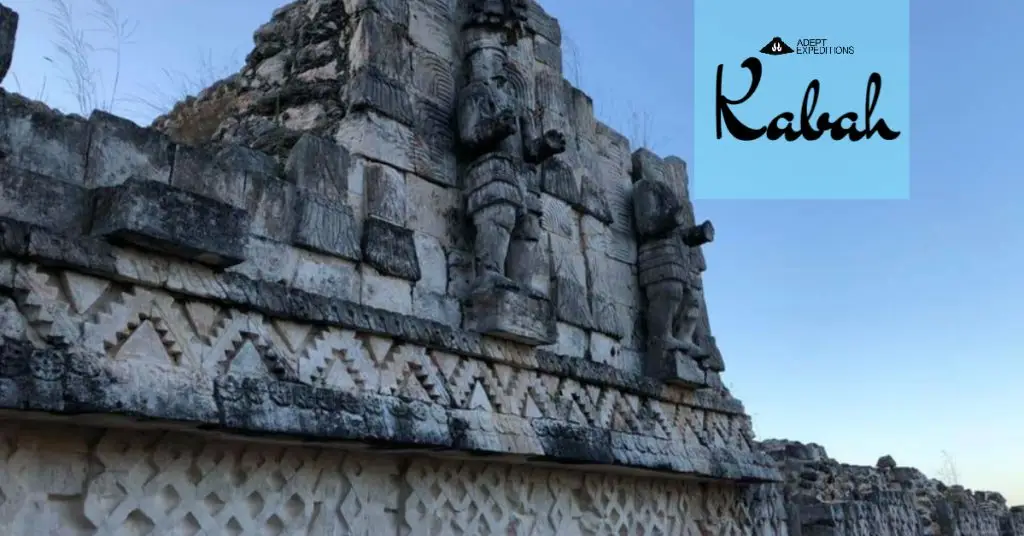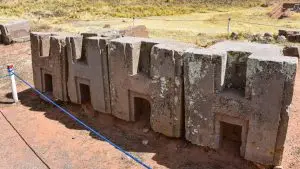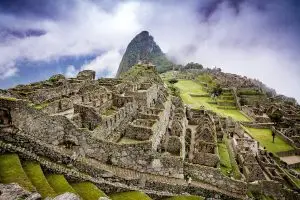Kabah Ruins
Situated in the Yucatan Pensinsula of Mexico, the Kabah ruins stands as a majestic ancient Maya archaeological site. Moreover, it was a significant city in its time, and its impressive architecture and urban design still exist today. Kabah, with its intricately adorned main stone structure, is a powerful reminder of the spiritual and symbolic significance of the Mayan civilization.
Experts recognize the Kabah ruins as a UNESCO World Heritage Site. It is also part of the Puuc Route, which highlights other impressive Mayan cities known for their architectural artistry.
Experts rank this archaeological site as the second largest in the area, despite Uxmal receiving more foot traffic. Sayil and Xlapa are other Puuc sites nearby. Visitors to Kabah can anticipate an unforgettable experience brimming with awe-inspiring ruins that transport them to another time period.
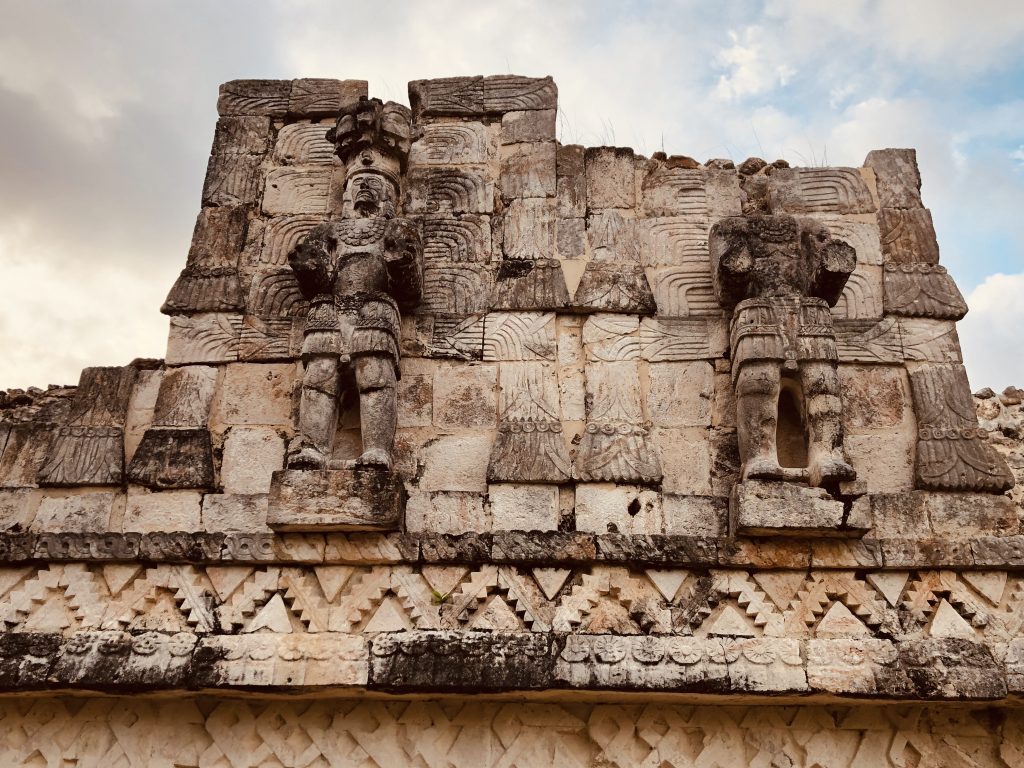
5 Interesting Facts About Kabah Ruins
1. Mayan Metropolis: Kabah was once a thriving Mayan city located in the Yucatán Peninsula of Mexico.
2. Architectural Marvels: The Kabah ruins gains renown due to its impressive architecture, featuring intricately carved stone facades and structures. It holds particular recognition for adorning its buildings with numerous stone masks depicting the Maya rain god Chaac.
3. Puuc Route Connection: Kabah is a key site on the Puuc Route, featuring ancient Mayan cities with shared architectural traits. This route includes Uxmal, Sayil, Labná, and other archaeological sites.
4. Rain God Symbolism: The profusion of Chaac masks on Kabah’s buildings shows its strong connection to rain and agriculture. These symbols highlight the importance of water in a region characterized by seasonal rainfall.
5. Unexcavated Mysteries: Much of Kabah remains unexcavated and hidden beneath the dense vegetation of the Yucatán jungle. The site’s limited accessibility adds to its mystery. Only parts of the ancient city have been uncovered, hinting at potential future discoveries. A Glimpse into the History of Kabah
The Name
In the world of historical marvels, Kabah, or Kabaah, reveals its name’s origin. Coined by Estanislao Carrillo in 1846, it stems from ancient Maya language, meaning “strong hand.”
Kabah is referred to as “the man with a strong and powerful hand,” a phrase associated with a stone carving at the site’s entrance. This carving portrays a figure, with unique non-Mayan traits, gripping a serpent.
This appellation, rooted in pre-Columbian times, is mentioned in the ancient Book of Chilam Balam of the Chumayel Maya. This means Kabah may be the original name for these ruins. However, an alternate moniker, “Kabahaucan” or “royal snake in the hand,” emerges from the insights of Teoberto Maler.
A Glimpse into the History of Kabah Ruins
The Maya inhabited Kabah as early as the 3rd century BC. During the Late Classic to Terminal Classic periods of Maya history (7th-11th centuries AD), the city experienced its cultural and architectural peak. It showcased the utmost artistic refinement and architectural prowess of the Mayan civilization, evident in the intricate designs visible in Kabah’s ruins today.
By the end of the 12th century, the inhabitants of the city had seemingly abandoned it. It wasn’t until the 19th century that explorers rediscovered Kabah and drew the world’s attention to it.
Pioneering the Unseen: Early Explorers’ Quest at Kabah Ruins
The site was first documented by the intrepid explorers John Lloyd Stevens and Fredrick Catherwood in the 1840s.
**Image of Catherwood*
Sylvanus Morley (1883-1948), an archaeologist and Mayanist, wrote about Kabah’s important role in his popular works on the Maya:
“During the eleventh and twelfth centuries, this section of Yucatan supported the densest population in the entire northern half of the Peninsula, a population which was gathered around many ceremonial centers, the most important of which was Uxmal…and the second largest, Kabah, located only nine miles southeast of Uxmal and connected therewith by a stone causeway.
Kabah was doubtless a dependent city of the Xiu state, since it was so near the Xiu capital [Uxmal] and, moreover, is connected with it by the causeway just mentioned.”
In the 1950s, Alberto Ruiz of INAH led an excavation and restoration project. Another restoration initiative was led by Ramon Carrasco in the 1990s. Even now, exploration, excavation, and restoration endeavors continue, deepening our understanding of the Maya civilization and its remarkable achievements. Meanwhile, scholars tirelessly analyze the ever-evolving significance of the symbolic monster mask motifs at Kabah.
The indigenous tradition of Kabah Ruins
If you’ve ever been to Uxmal, you’re likely familiar with the legend of the dwarf. Some say his mother hailed from the little-known village of Nohpat. However, during the height of the Uxmal Empire, a variation of the legend emerged within the city of Kabah.
In Kabah, resided an elderly sorceress, a revered figure in the city’s oracle.
Despite her wisdom, she longed for a child, her heart aching with an unfulfilled desire. With unwavering devotion, she beseeched the deity “Chic Chan” for a miracle. One fateful day, Chic Chan appeared, telling her to care for turtle eggs at the cenote. Faithfully fulfilling this sacred duty, she made an extraordinary find—a remarkably large egg. Nurturing it, months later, it hatched to reveal a child with a captivating otherworldly green hue. This cherished child, named “Saiyawincoob,” became the center of her world.

Over time, his stature stayed the same, but subtle signs started appearing—his voice changed, a beard grew—revealing his true dwarf form and unraveling Kabah’s mystical tapestry of history.
Exploring Kabah’s Architectural Marvels: A Comprehensive Overview of Architecture at Kabah
Kabah’s layout divides broadly into several groups, each featuring unique structures and edifices, including:
- The East Group
- The Central Group
- The West Group
- The Early Group
- The Northwest Group
In addition to the various groups, researchers have uncovered several tombs within the site.
Diverse Architectural Groups at Kabah
The most impressive and frequently visited section is the East Group, home to the Palace of the Masks or Codz-Poop. More than 250 masks, thought to depict the rain god Chaac, decorate this impressive structure, showcasing Maya craftsmanship and spirituality. Other attractions in the East Group include the Royal Palace and the Temple of the Columns. However, please note that the latter is currently inaccessible to visitors.
The Central Group is located to the west, just across Highway 261. Prominent structures at the site include the Quadrangle, Teocalli (The Great Pyramid), and the iconic Arch of Kabah. This arch serves as a ceremonial causeway connecting the Kabah ruins to Uxmal, another important city on the Puuc Route. This arch, in essence, symbolizes the interconnectivity between the various cities of the ancient Maya civilization.
The West Group, along with the Early and Northwest Groups, comprises intriguing structures like the Red Hands Building and El Mirador (The Observatory). Unfortunately, these impressive structures remain unexcavated and inaccessible to tourists.
Unveiling the Unexplored: Further Discoveries Await at Kabah
The ruins of Kabah have stood the test of time, their function and significance cloaked in mystery. Excavations and research unveil exciting opportunities to explore the intriguing Maya civilization.

Despite its expansive nature, a relatively small portion of Kabah is accessible to tourists. Many secrets of the ancient Maya civilization still lie undiscovered in unexcavated parts of the site.
The East Group predominantly serves as the main focus of this blog and is where visitors are primarily allowed access. Codz-Poop features a breathtaking collection of monster masks and intricate structures that showcase Maya architecture.
The East Group
- Hieroglyphic Platform
- Codz Poop: The Pyramid of the Masks
- Royal Palace
- Temple of the Columns
This Complex rests upon a substantial three-tiered platform (approximately 339ft/103m x 107ft/32m). A stairway facing westward guides to a spacious plaza. On the plaza’s southern edge, an unrestored step pyramid temple with multiple ruined summit chambers stands. Accessible through a central plaza stairway, a small ruined structure occupies the plaza’s northern side.
Within the plaza, a Hieroglyphic Altar is located.
Hieroglyphic Platform
The hieroglyphic altar at Kabah currently presents itself as a low platform featuring stairways on its west side. It spans 21 ft on each side. Its significance lies in the multitude of glyph blocks integrated into its sides. When Stephen’s and Catherwood visited the site during the mid-19th century, the platform had already suffered destruction and looting.

A collection of 144 stone blocks, adorned with carved bas-relief glyphs, awaits discovery. During a 1950s restoration effort, 54 of these blocks were repositioned onto the platform. However, others linger nearby, poised for their restoration. Clearly, the inscription work took place subsequent to the platform’s construction, as particular glyphs span across multiple stones.
The deciphered text unveils insights into royal authority, date ascensions, rituals, and military triumphs. The scribal style indicates crafting by multiple artisans, eaching showcasing their degree of skills. These inscriptions chronicle pivotal ascension dates and ritual acitivity, bestowing invaluable historical knowledge. Despite weathering, the platform stands tall, a tribute to Maya ingenuity in writing and in their understanding of astonomy.
However, the complete message remains a mystery, as researchers have not yet fully deciphered the inscriptions. Deciphering the entire panel of glyphs is still a challenge, offering more secrets about Kabah and the Maya civilization.
Water Wizards: The Cistern of the Rain God, Chaac
The plaza also contains a water catchment system constructed below the plaza surface.
In Yucatan region, the climate is tropical. It has dry conditions from November to April and a rainy season in summer, with an average rainfall of 44 inches. Like other Puuc sites, Kabah lacks permanent water sources. The closest is the Xlacah cave, about two and a half miles to the south. This created a significant reliance on rainfall.
The main challenge faced by urban inhabitants of Puuc was water storage. They built underground reservoirs, called chultunes in Yucatec Mayan, strategically positioned to collect runoff. These chultunes had a rounded shape, slightly sloping towards a 20-foot wide intake. It experiences dry conditions from November to April and a rainy summer season, with an average rainfall of 44 inches. Currently, restoration has been undertaken on this chultune, providing the site’s sole water supply.
Codz Poop: The Palace of the Masks
The Codz Poop, or the Palace of the Masks, is the most notable structure in the West Group of Kabah. Built between 700 and 900 AD, historian Enrique Juan Palacious called this a “decadent instance of native baroque architecture”. Without a doubt, it exudes a distinctive Mayan flamboyance that is hard to miss.
Stretching over 170ft/55m in length, the remarkable monument bears the Mayan name Codz Poop. This name means “rolled up straw mat,” symbolizing authority, inspired by the ornate roof-comb of the primary wall. The facade boasts seven rows of over 250 masks, widely thought to represent Chaak, the Maya civilization’s rain deity. Nevertheless, the symmetry of these masks is disrupted at the center by doorways accentuated with a Chaak nose. The interior also presents similar mask motifs.

The Mystery: Chaak, Itzam Cab Ain or Witz Monster Masks?
Recent studies present a compelling alternative interpretation. Scholars suggest the masks could represent Itzam Cab Ain, the alligator deity, the earthly manifestation of Itzamna. Intricate design and symbolism hint at its significance within ancient narratives. This revelation could refine our view of Kabah’s religious architecture. Overlapping Chaac and Itzam Cab Ain symbols could unveil celestial-terrestrial interplay in Maya cosmology.
Chaac masks spark speculation about Kabah’s true meaning. Some see links to Flower Mountain’s Classic Maya imagery, solar-water symbolism. Flower Mountain connected to sun-maize deities, embodying Witz monster. “Witz” (hill) links to motifs symbolically. Karl Taube’s research challenges Chaac association. Masks could represent Flower Mountain, resonating in Mesoamerican origin stories, Olmec presence reinforcing.
Within this context, the Chaac masks at Kabah could potentially represent symbolic representations of the Flower Mountain masks.
Thus, the Codz Poop remains a fascinating subject of study. It offers profound insights into the spiritual world of the ancient Maya civilization. The intricate detail and craftsmanship of each mask reveal the Maya’s high regard for this deity. This of course, reflects the cultural importance of rain and water in their society.
The West Facade of Codz Poop
Its western façade boasts over 250 masked motifs, with artisans meticulously fashioning each motif from 30 individual mosaic stones. These Chenes-style masks are a remarkable labor of artistry, presenting a breathtaking spectacle.

This palace side has five double-vaulted chambers accessed through single doorways, with single chambers on the north and south sides. The palace stands on a three-tiered platform, facing a raised plaza, accessible via a grand staircase.
A decorative roof comb crowns the palace, adding an illusion of greater height and magnificence. An absolutely breathtaking spectacle in the radiant sunlight, perhaps intentionally designed to convey esoteric symbolism.
The East Facade of Codz Poop
The East side of Codz Poop is equally impressive, presenting a unique set of architectural features that reflect the Maya’s extraordinary craftsmanship and deep spiritual beliefs.
Unlike the West side, the East side does not feature a multitude of so-called Chaac masks. Instead, a series of intricately carved statues and glyphs adorn it, each carrying its own narrative from the Maya civilization.
Seven statue pedestals were originally positioned on the rear face, but currently, only two statues remain in their original positions.

The statues display an impressive level of detail, believed to depict the Maya elite warriors and commonly referred to as the King of Kabah. While several rulers have been identified, one of them is also depicted on the jamb of Room 21 within the same building.
Each figure is meticulously crafted, revealing the skillful precision and creativity of Maya artisans. These statues stand as silent sentinels of Kabah’s past, embodying the cultural richness and spiritual depth of the ancient city.
Adorned with finely carved door jambs depicting rulers, captives, and glyphic details, Codz Poop also boasts an intriguing find: an inscribed date of 987 A.D. on one of the jambs. This date stands as the most recent known carving in the northern Yucatan region.
Eroded Yet Significant: The Enduring Messages of Kabah’s Glyphs
Despite erosion, researchers believe the glyphs hold valuable information about Kabah’s rituals, beliefs, and historical events. Decoding them could reveal fascinating aspects of Maya civilization, offering insights into their way of life. The East side of Codz Poop remains a focal point for archaeologists and historians worldwide.
The south side of the plaza showcases the un-restored Great Pyramid, also known as Teocalli. It has an oval shape reminiscent of the Pyramid of the Magician at Uxmal. The temple walls’ remains are visible and accessed via a large east-side staircase, flanked by rooms.
Among the structures to restore are low platforms and room groups surrounding a central patio. Stephens initially described the Teocalli as grand, picturesque, ruined, and covered with trees, standing prominently on the plain. Ruined apartments lie at its base, with fallen steps and loose stones making the sides challenging to climb.
The restored front portion. The ground floor has chambers accessed through doorways, while a second story, reached by a plaza stairway, holds vault chambers.Another stairway is on the west side with restored chambers.
Partially restored structures occupy the southwest, northwest, and north plaza. The north structure houses rooms with a vaulted chamber, a platform featuring a standing stela, and a chultun (storage well) at the center of the plaza. Dominating the east side of the plaza is the main structure, the Royal Palace.
The Royal Palace
Adjacent to the Codz Poop stands another significant structure, the Royal Palace. Spanning across three buildings, this grand edifice stands out for its 34 vaulted rooms. These rooms, though now partially collapsed and weathered by time, showcase the architectural mastery of the ancient Maya.
Tatiana Proskouriakoff compared the Palace to the “baroque ostentation” of the Codz Poop. She writes: “Certainly in its present form it [Codz Poop] fails to score against the rhythmic simplicity of the classic Puuc tradition expressed in Structure 2, the two-story palace seen in the background, which is more severe, more restful, and more consistent in design.” –Tatiana Proskouriakoff, An Album of Maya Architecture, p.68
These vaulted chambers are a testament to the Maya’s expert use of space and architectural design.
The’s rooms suggest they may have been residential and a royal kitchen for Kabah’s elite.Further explorations and restorations may unveil insights into the daily life and social structure of the Maya civilization. Each room in the palace has the potential to reveal more information.
John Lloyd Stephens’ Remarkable Assessment of Kabah Ruins: Insights from the 19th Century Explorer
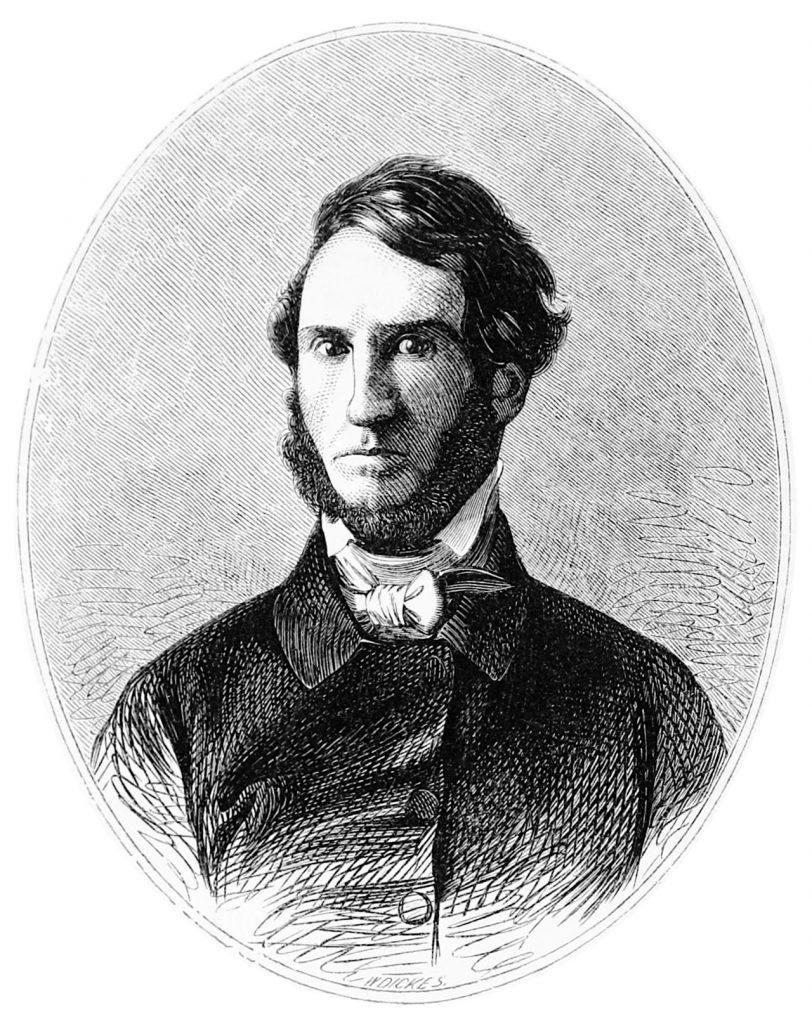
In 1842, John Lloyd Stephens embarked on a visit to Kabah. He provided a vivid description of the courtyard, which had measurements of 170 feet in length, 110 feet in width, and an elevation of 10 feet from the ground. During his visit, the courtyard had undergone clearing and corn planting, infusing vitality. Within this remarkable space, Stephens encountered a captivating sight: a toppled “picote,” also known as a great stone. Years later, Pollack found the stone, called a “column altar,” broken during his 1950s visit. Thankfully, it has been meticulously reassembled and now proudly stands on the central platform, near the Royal Palace and Codz Poop.
From the rear of the Royal Palace, one may see the majestic Temple of the Columns, a testament to the architectural prowess of the ancient Maya. Despite its distance, the structure’s distinct columns and intricately carved facades are clearly visible, evoking awe and wonder. The Temple of the Columns, however, remains a tantalizing enigma for most visitors. As a component of the effort to uphold the site’s integrity and safeguard its delicate structures, authorities restrict public access. Though tourists can’t closely explore it, this decision highlights the importance of preserving our cultural heritage for future generations. Even from a distance, the Temple of the Columns remains a mesmerizing testament to the splendor and sophistication of the Kabah ruins, inviting us to explore the mysteries of the ancient Maya civilization.
The Central Group of Ruins
Regrettably, tourism frequently encounters closure regarding the Central Group of the Kabah ruins. Nevertheless, with a sense of adventure or the guidance of a willing guide, there are instances where deeper exploration into Kabah’s mysteries becomes possible. Unlocking the gate or relying on a key holder can facilitate access to the East Group.
The Great Pyramid of Kabah, or Teocalli
The esteemed High Temple, also known as Teocalli, graces the path to Campeche, nestled between the Eastern and Western Groups of Kabah. This pyramidal structure, composed of multiple tiers, boasts a shrine’s remnants atop its summit. Today, it appears to be as a collection of loose stones, gracefully ascending the tree line at the roadside, encircled by several dilapidated structures.
Historians speculate that this edifice, ingeniously erected on a natural elevation, functioned as a “House of the Gods” or Teocali. Within its walls, priests and rulers conducted sacred rites and received divine messages, aligning with the revered traditions of the Central Mexica (Aztec) people.
The Famous, but rarely visited Mayan Arch of Kabah
The iconic Arch of Kabah, executed in the Early Puuc Style, stands as a symbol in this city. It bears resemblance to the Arch of Triumph, serving as a symbolic marker for the start of the Sacbé (causeway) leading to Uxmal. Dating back to around 670-770 A.D., its architectural style aligns with this period. The outer decoration features plain walls and small horizontal moldings that highlight the significance of the opening. Notably, somewhat faded red-colored handprints still adorn the inner masonry blocks of the Arch.
Situated on the west side of the Great Pyramid, this remarkable construction, along with the pyramid itself, holds a central role in the city’s ceremonial life. With its monumental size and elegant lines, the Arch of Kabah showcases the mastery of Mayan architecture and stands as an unparalleled work of art.
Archaeologist H.E.D. Pollack noted remains of a decorative openwork roofcomb atop this arch in the 1930s, which are no longer visible today.
Unveiling Kabah’s Ancient Pathways
The ancient Maya city of Kabah gained recognition for its sacbe, an elevated road system that held great significance within Maya civilization. One of the most notable sacbes extends from Kabah to the lesser-known site of Nohpat, and finally to the renowned city of Uxmal. This sacbe, or white road, was more than just a means of transportation, it was a symbol of power and connectivity between these ancient cities.
Spanning a length of over 18 kilometers, this sacbe ranks among the longest ever uncovered in the Maya world. It is thought to have served as a significant ceremonial pathway, playing a crucial role in religious rituals and processions. Its construction reflects the remarkable engineering skills of the Maya, as it navigated through the challenging topography of the region with remarkable precision.
The Enigmatic Sacbe Network
Just as today’s highways connect our modern cities, the sacbe of Kabah, Nohpat, and Uxmal served as a tangible link between these urban centers of the Maya civilization. The sacbe not only contributed to the movement of people and goods but may have also facilitated the exchange of ideas, cultural practices, and belief systems between these cities. It stands as a testament to the advanced civilization of the Maya, their understanding of geographical layouts, their socio-political structures, and their incredible ability to adapt to their environment.
This remarkable sacbe continues to be a significant research focus, offering valuable insights into the complexities of the ancient Maya civilization and their sophisticated urban planning techniques. The sacbe from Kabah to Nohpat to Uxmal remains a silent yet powerful witness of the grandeur of an era long past, leaving visitors with a deep sense of respect and admiration for the Maya people.
The West Group
- West Quadrangle
- Temple of the Keys
- Temple of the Architraces
- The Red Hands Building
- El Mirador (The Observatory)
Temple of the Architraves
Among the constellation of significant structures in the Kabah ruins, the Temple of the Architraves holds a distinct place. Located in the West Quadrangle, this temple is a quintessential representation of the Puuc architectural style that is so characteristic of the region.
The Temple of the Architraves exudes a sense of majesty and grandeur, showcasing the zenith of Maya artistry and architectural proficiency. The temple’s exterior is covered in elaborate and intricate carvings, which display deep-rooted symbolism and iconography of the Maya civilization.
The name ‘architrave’ refers to the ornate lintels, which adorn the entrances of the temple. These architraves are a testament to the advanced stonework and craftsmanship of the Maya architects. They are intricately engraved with glyphs and figures, reflecting the rich cultural narratives and spiritual beliefs of the Maya. However, centuries of exposure to the elements have weathered these carvings, yet they retain a sense of awe-inspiring beauty.
The Temple of the Architraves stands as a silent beacon of a bygone era, carrying the whispers and echoes of ancient rituals, ceremonies, and the daily life of the Kabah inhabitants. It continues to captivate archaeologists, historians, and tourists, offering invaluable insights into the Maya civilization. Its continued preservation is vital for future generations to engage with and appreciate the depth and breadth of the ancient Maya cultural heritage.
Unfortunately, the site’s discoverer, John Stephens, took the architraves and brought them to New York, where they were later destroyed in a fire.
Practical Tourism Information for Visitors
Touring the Kabah ruins is an enriching experience that takes you back to the time of the Maya civilization.
The site sets an affordable admission rate of 70 MXN, ensuring that this historical treasure is accessible to everyone. The site operates throughout the week, from Monday to Sunday, with visiting hours from 08:00 am to 05:00 pm. These hours offer ample time to thoroughly explore the architectural wonders of Kabah and immerse yourself in its intriguing history.
Hours: 8:00 AM – 5:00 PM
Admission: 70 MXN ($3.75 USD)
Amenities: Restrooms, water, soft drinks, handicrafts
Museum on-site: Not available
Accomodations: None on-site
GPS Coordinates: Latitude 20° 15′ 13″ N, Longitude 89° 39′ 19″ W
Tips for Visiting Kabah
Is Kabah Ruins worth Visiting?
Indeed, a visit to the Kabah ruins is a remarkable journey into the heart of Maya civilization. The site’s impressive architecture, intricate stone carvings, and the mystery surrounding the glyphs offer an enriching exploration of ancient culture. This UNESCO World Heritage Site offers a unique chance to explore the Maya’s brilliance in urban planning, art, and spirituality. Walking through the same pathways that the Maya did centuries ago, one can’t help but marvel at this civilization’s progressiveness and sophistication. Kabah’s ruins, therefore, offer an unforgettable experience for history enthusiasts, archaeologists, and curious travelers alike.
We highly recommend arriving early to avoid the scorching midday sun. If you want to experience the captivating effects of sunlight on Codz Poop, it’s worth visiting during that time. The site also boasts an ornate roof comb that creates the illusion of greater height and grandeur. It truly is a breathtaking sight when bathed in sunlight. Regardless of when you go, make sure to allocate ample time to fully appreciate this extraordinary site.
Please note that there are no dining facilities on site and limited eating options in the vicinity. It might be wise to bring your own snacks.
Getting to Kabah
Reaching the Kabah ruins is relatively straightforward as it is conveniently located along Highway 261, approximately 23 km south of Uxmal and 140 km southwest of Mérida. Public transportation is available from Mérida, with buses departing every hour from the main bus terminal. For those driving, the journey offers an opportunity to enjoy the scenic beauty of the Yucatán Peninsula. There is ample parking available at the site entrance. Alternatively, one can join a guided tour from Mérida or Uxmal, which typically includes transportation, a guided visit, and sometimes even a meal. Regardless of how you choose to get there, a trip to Kabah promises a memorable journey into the heart of the ancient Maya civilization.
How Long to Visit Kabah?
On average, a comprehensive tour of the Kabah ruins takes approximately 30-45 minutes. This duration allows visitors ample time to explore the main structures such as the Codz Poop, the Palace, and the Sacbe, while also providing opportunities to appreciate the intricate stone carvings and glyphs scattered throughout the site. However, the timing for this can vary depending on individual interests, pace, and whether one chooses to opt for a guided tour. Visitors with a keen interest in archaeology and Mayan history may find themselves spending more time delving into the site’s rich historical narratives.
Where to Stay When Visiting Kabah?
When planning a trip to the Kabah ruins, accommodation is an essential factor to consider. If you want to be close, Uxmal is nearby – just 23 km north of Kabah. Stay in luxury at The Lodge at Uxmal or Hacienda Uxmal Plantation & Museum for amazing views of Uxmal ruins, or go for the budget-friendly Hotel La Casa Del Mago.
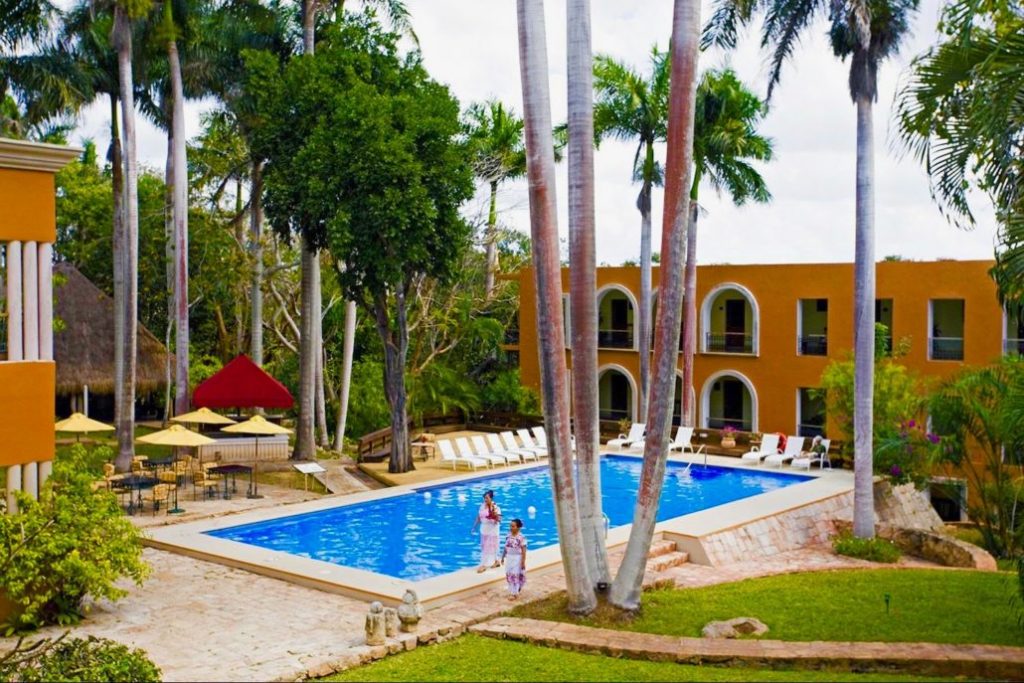
Alternatively, the city of Mérida, approximately 140 km northeast of Kabah, offers a wide range of accommodations and the excitement of city life. From boutique hotels in the historic center to modern resorts, Mérida has options for every budget and preference.
When choosing accommodation, prioritize easy access to Kabah. Whether it’s a quick drive or public transportation, ensure convenience. Your lodging should enhance your journey into the heart of Maya civilization, offering a comfortable retreat after exploration.
Exploring the Puuc Route
Taking a tour of the Puuc route is a must-do for any visitor to the Yucatán Peninsula. The Puuc Route displays a distinctive architectural style with intricate stone mosaics and elaborate pilasters. It includes the archaeological sites of Uxmal, Kabah, Sayil, Xlapak, and Labna, offering a glimpse into the archaeology of the ancient Maya civilization.
Adept Expeditions organizes tours along the Puuc Route. These tours offer transportation, expert commentary on history and architecture, and a traditional Yucatecan lunch. It’s a full-day adventure starting with Uxmal, followed by Kabah, and then lesser-known ruins: Sayil, Xlapak, and Labna.
Explore the Puuc route independently or with a guided tour for a captivating journey through time. Encounter exquisite ancient Maya architecture at each site, such as the grandeur of Uxmal and the intricate ruins of Labna. Uncover the unique stories of this advanced civilization, making a Puuc tour an unforgettable part of your Yucatán experience.
